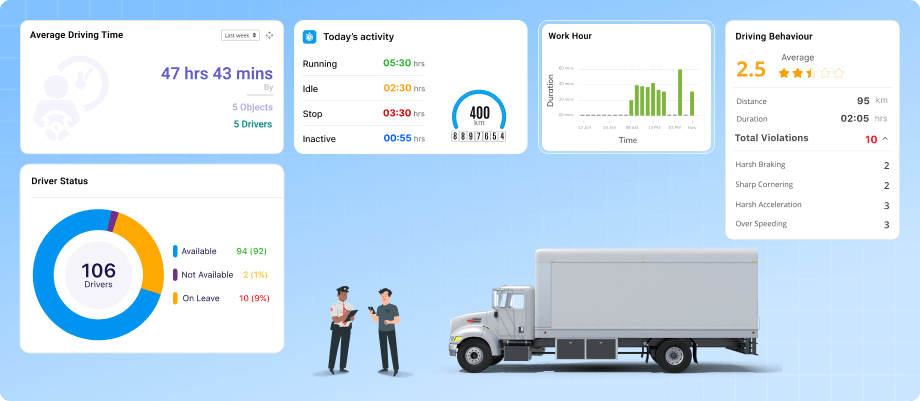In the United States, ELD (Electronic Logging Device) compliance is mandatory for most commercial vehicles under FMCSA regulations. But ensuring accurate Hours of Service (HOS) tracking across fleets is still a major challenge. Many operators rely on outdated systems that fail to update duty status in real time or warn drivers before a violation occurs. This leads to DOT(Department of Transportation) fines, increased downtime during inspections, and scheduling inefficiencies. U.S.-based fleet operators now need smarter, automated tools that not only ensure compliance but also make driver management simpler and audit-readiness faster.
Ensuring ELD compliance and HOS accuracy with fleet tracking in the U.S.
Introduction
Challenges
- No real-time visibility into driver hours: Fleet managers struggle to view a driver’s remaining hours in real time. Without accurate HOS visibility, over-assignments become common and risk non-compliance with FMCSA driving limits.
- Frequent HOS violations due to manual planning: In the absence of integrated systems, some fleets still rely on paper logs or fragmented tracking tools. This leads to missed rest breaks, overlapping shifts, and automatic violation triggers.
- Delays during roadside inspections and audits: Without centralized log storage, accessing historical HOS data during inspections or DOT audits becomes slow and disorganized, often resulting in citations or prolonged vehicle holds.
- Drivers face difficulty managing logs on the go: Many drivers struggle with complex interfaces or forget to switch duty status. This leads to unintentional errors that can’t be corrected in time, putting both the driver and fleet at risk.
Solution
- Live HOS dashboard with real-time availability: Fleet managers can track each driver’s current duty status: driving, on-duty, off-duty, rest, and remaining allowable hours to assign trips accordingly and reduce compliance risks.
- Automatic status detection and violation alerts: The software detects vehicle movement and driver status. It also alerts the admin when they approach HOS limits, minimizing chances of overstepping thresholds.
- Instant access to electronic log history: During roadside inspections, logs can be pulled instantly from the system and shown to DOT officers. The same applies to audit requests, reducing administrative effort and penalty risk.
- Simplified mobile interface for drivers: Drivers get an easy-to-use app to log their duty. View their daily/weekly hour and receive driver-related alerts or upcoming HOS, ensuring stress-free compliance.
Results
- Fewer driving violations and safety risks: With real-time monitoring and driver scorecards in place, many fleet operators in the UK and Germany observed a sharp decline in unsafe driving behaviors. Fleets reported fewer speeding events, harsh braking incidents, and accident-related downtime.
- Higher vehicle inspection compliance: Digital DVIR tools improved daily inspection routines, making it easier for drivers to submit accurate reports. This led to quicker identification of vehicle issues and enhanced overall fleet safety and roadworthiness.
- Reduction in regulatory fines and access restrictions: By using automated compliance tools for tachograph data and regional mandates. Fleets were able to operate more confidently in regulated areas. Businesses experienced fewer penalties and smoother access through zones with DVS and emission rules.




